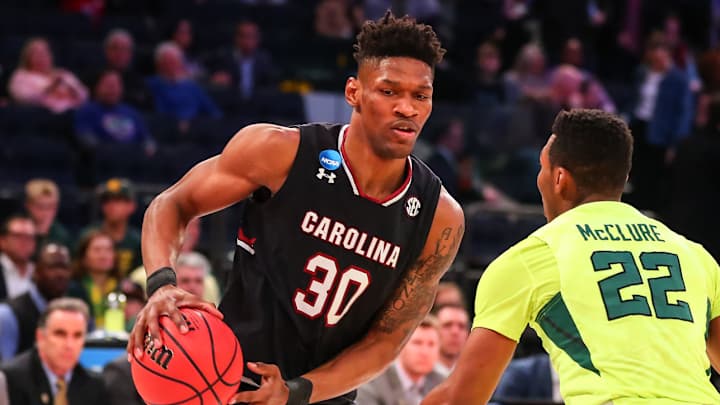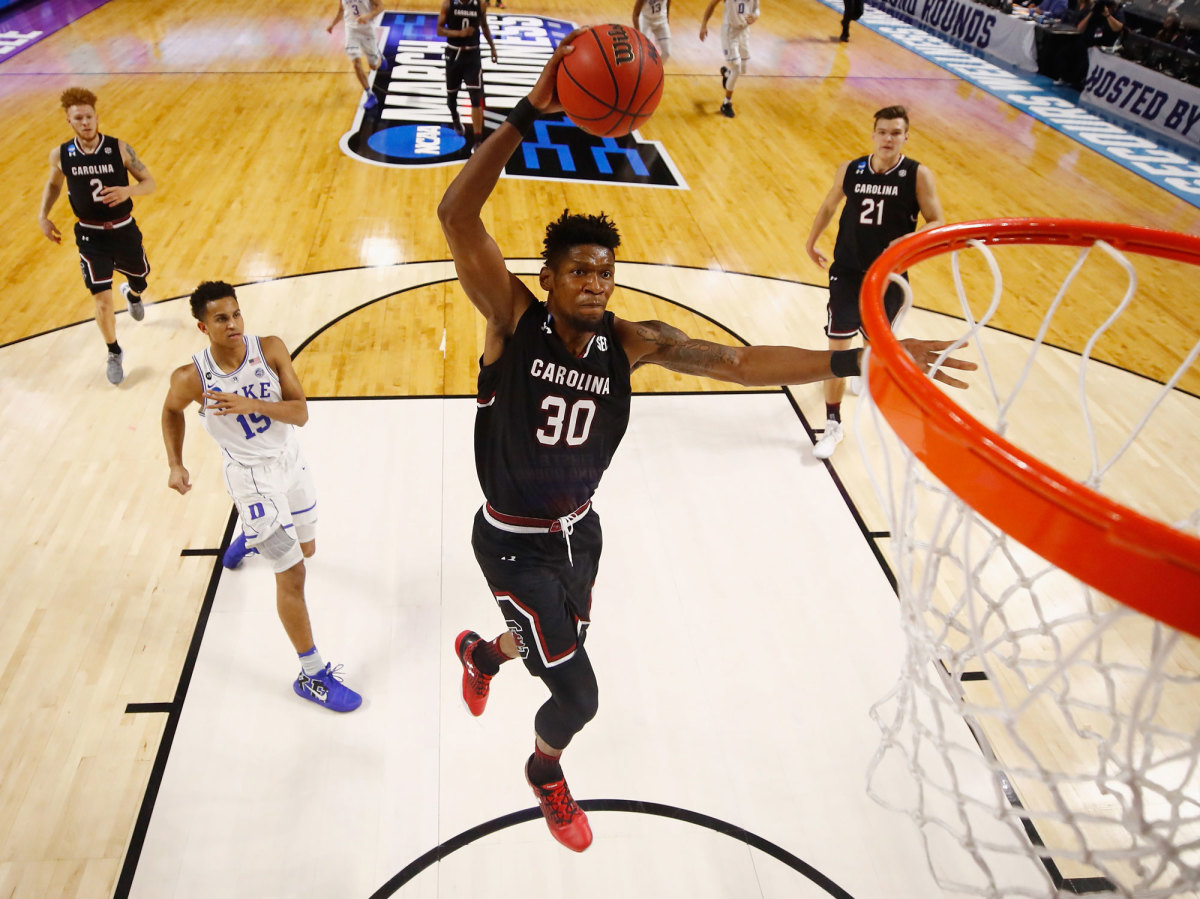Once a basketball novice from Gabon, Chris Silva is now a key piece for South Carolina

He stared out the window from the passenger seat of a Nissan Altima, his seat reclined slightly so that his head would not scrape the car’s ceiling. Chris Silva was 6’ 8” and a few days shy of 16 years old, and he had just landed at New York’s JFK Airport after the last of his four flights from his home country of Gabon to the United States, where he would now be living and playing basketball. The car’s driver was Tommy Sacks, an associate head coach at Roselle Catholic High in New Jersey, who had seen a 15-second video of Silva demonstrating some rudimentary basketball skills on an outdoor canopied court and saw enough to decide to help Silva move stateside and play for him. They were now driving across the Verrazano Bridge that connects Brooklyn and Staten Island and Sacks pointed northeast, toward the distant skyscrapers of Manhattan. Silva spoke French and Cape Verdean Creole but little English, and so his response was not verbal, but it was clear. “He was kind of in awe,” remembers Sacks. “He’s just nodding, and has this beautiful smile.”
There is a familiar trope in play here. A young person abroad shows athletic promise, is discovered through some sliver of performance that projects a heap of possibility, and then is shipped to this country to convert the potential to actual for the ostensible benefit of all involved. But that takes nothing away from the impressive truth of what Silva has done, which he has done for so many reasons, not least of all his own sheer will. On Sunday, some four-and-a-half years after riding across that bridge on the way to playing his first true organized basketball, Silva will take the floor in one of that awesome city's most famous buildings with a chance to reach his sport's grandest amateur stage. South Carolina is playing in its first ever Elite Eight and on the verge of its first Final Four for many reasons, among them a tireless defense, the remarkable guard Sindarius Thornwell and the underappreciated coaching of Frank Martin. One of the least expected is the sophomore, a relative basketball novice, who emerged as a forceful inside presence against Duke’s fleet of future pros and Baylor’s previously dominant frontline.
“He’s been our piece of deciding whether we’re gonna win or lose,” Gamecocks assistant coach Matt Figger says of Silva. “When he plays, we win.”
South Carolina smothers Baylor to advance to Elite Eight
By the standards of an American teen, the boy riding across the Verrazano on that September 2012 afternoon had hardly played basketball at all. Silva’s father, a furniture builder, was a member of the Gabonese national team, but the country lacked a youth hoops infrastructure, and so Silva could only play in informal games on playgrounds around Libreville, a coastal shipping city of 700,000. Soccer ruled the local sporting scene. With no NBA games locally televised, basketball was hardly seen at all. Silva and his friends often learned the names of American basketball stars through sneakers on sale—Jordan, LeBron, Melo—then scoured YouTube to discover the corresponding faces and games. At 14, Silva began playing with a club called Espoir, alongside men twice his age or more. “The only players that play back home are grown players who go out of the country and come back,” says Silva. “It was physical.”
It was around this time that Silva encountered Joe Touomou, a Cameroonian-born guard who played with Allen Iverson at Georgetown in the mid-1990s and now served as a scout of African basketball talent. Touomou filmed a quick clip of Silva executing basic basketball tasks and sent it to Sacks, whom he knew from the American AAU scene. Sacks was smitten. “He was quick as a cat,” the coach remembers. “Boom, you give him the ball, he would spin off and go to the basket. There was about six seconds of shooting. You could see he is a natural shooter.”
Sacks began helping arrange for Silva to move to the U.S. to play for him. Silva knew just one person in the country—his uncle Miguel, who lives in Boston—and practically none of its language. During his multiple layovers on his way to New York, he was adrift in a sea of unfamiliar tongues. “I was scared of getting lost,” Silva says. “I don’t really know how I got to the next plane. I think I was just following people and they happened to get to the plane I was going to.” Ultimately he arrived without incident, where he greeted Sacks with a purposeful soundbite of the little English he knew: “Coach,” Silva told him, “I go NBA.”
Work began immediately, with three workouts that same day. Silva attacked the language barrier in much the same way, using Google Translate on his school-issued Android tablet to understand homework word problems or churn out essays. On the court, for all the obvious upside he displayed, there were clearly kinks to work out too; the first time he was substituted into a game, he neglected to check in at the scorer’s table and earned a technical foul when he walked into the floor. But Sacks, who worked under head coach Dave Boff, was adamant that Silva be used as a starter and see extended minutes. “I said, ‘You have to go with this kid now because he’ll pay dividends later.’” By the end of his first season, Silva was helping shut down future No. 1 overall NBA Draft pick Karl-Anthony Towns in New Jersey’s state championship.

Figger first saw Silva while recruiting future Syracuse forward Tyler Roberson, Silva’s teammate at Roselle. Figger, who was then on Martin’s staff at Kansas State, was taken by the same apparent tools that had won Sacks over: Silva’s big hands, long limbs, indefatigable energy. Their communication over text messages was not always the most substantial (“He would just say ‘lol,’” says Figger. “I could say something dead serious to him and he’d go, ‘lol.’”) but everything the coach saw showed him that Silva would be perfect for Martin’s program. During one game an opponent tried to dunk on Silva, triggering a skirmish that nearly came to blows. “And the next possession down,” Figger recalls, “they throw a lob to Chris and he dunks on the same kid that he almost had a fist fight with. That was one of the moments where I was like: He fits our mold.”
This is an important aspect of what is now South Carolina’s identity under Martin. On Friday he was asked whether technique or attitude was more important to his team’s defense, and his answer was unequivocal. “Attitude comes first,” he said. “We’ve got to have guys that are going to believe in our mission, that are going to believe in what we want to do. Once they believe, then we can teach them the technique. It all starts with our mindset.”
Here Silva’s natural aggression helped earn him immediate playing time as a freshman. But it does not come without its prices. One is often felt by teammates in practice. ”Man, I’ve gotten my lip busted at least 10 times this year from him, just trying to get a rebound, and I don’t even guard him,” says sophomore Hassani Gravett. “But you want somebody that’s gonna be that bruiser. He’s not a cheap or dirty player, but he’s gonna go with that Russell Westbrook motor all the time.”
Frank Martin and South Carolina's surprising Cinderella story written by senior trio
The other comes in games, when Silva too often finds himself on the wrong end of a referee’s whistle. As a freshman he committed 9.4 fouls per 40 minutes, fouling out of three games and picking up four fouls in 12 more. But the Gamecocks’ coaches are careful not to rein in the type of effort that makes Silva effective in the first place. ”When he’s trying not to foul, he loses his aggressiveness and doesn’t guard anybody,” Figger says. “It’s like you gotta ride that bronco as long as you can before he bucks you off. You don’t wanna tame him because that’s who he is.”
In the first three NCAA tournament games of Silva’s young career, he has struck that careful balance, averaging 3.7 fouls in 27.0 minutes but also 13.0 points and 7.3 rebounds. He followed a double double (17 points, 10 boards) in South Carolina’s rollicking second-round upset of Duke with 12 and seven against Baylor in Friday’s 70–50 Sweet 16 win. As important in that game, during which Silva displayed a deft short-range touch, was the way he helped smother and stifle Baylor forward Johnathan Motley into long stretches of near-total ineffectiveness, bringing the Bears’ offense down with him.
Afterwards, Silva took to the press conference dais alongside Thornwell and Duane Notice, as comfortable in his growing language as he is in his growing game. “This is like a dream come true for that kid,” says Sacks.
The next day, after South Carolina moved into the Knicks’ locker room for the rest of the weekend, a reporter told Silva that the spot he was assigned normally belonged to Carmelo Anthony. Silva was asked what he would have thought had he been told such a thing a few years ago. “It can’t be true,” he said. “That’s way beyond my thinking.” He had seen so far out that window, but not quite this.
